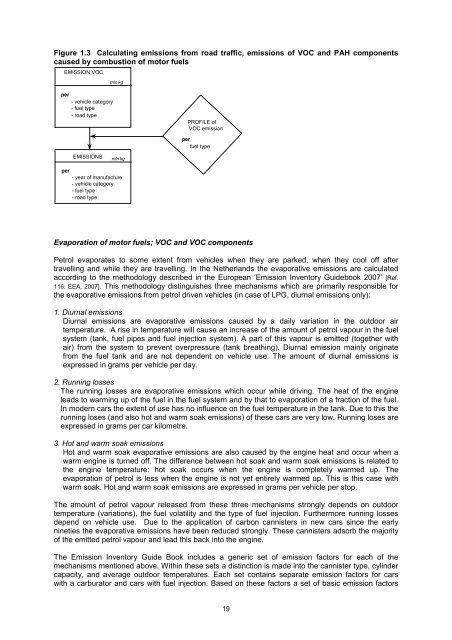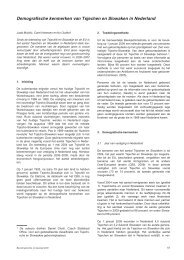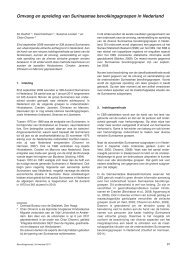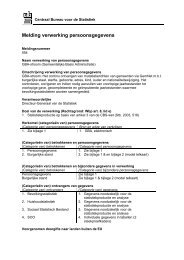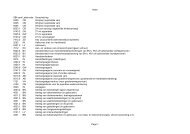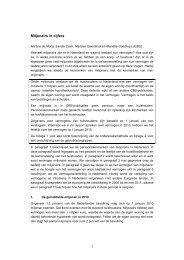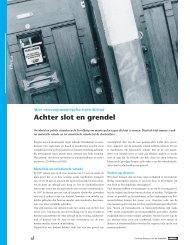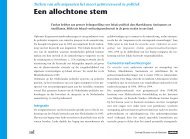Methoden voor de berekening van de emissies door mobiele ... - CBS
Methoden voor de berekening van de emissies door mobiele ... - CBS
Methoden voor de berekening van de emissies door mobiele ... - CBS
You also want an ePaper? Increase the reach of your titles
YUMPU automatically turns print PDFs into web optimized ePapers that Google loves.
Figure 1.3 Calculating emissions from road traffic, emissions of VOC and PAH components<br />
caused by combustion of motor fuels<br />
EMISSION VOC<br />
per<br />
per<br />
- vehicle category<br />
- fuel type<br />
- road type<br />
mln kg<br />
EMISSIONS mln kg<br />
- year of manufacture<br />
- vehicle category<br />
- fuel type<br />
- road type<br />
PROFILE of<br />
VOC emission<br />
per<br />
fuel type<br />
Evaporation of motor fuels; VOC and VOC components<br />
Petrol evaporates to some extent from vehicles when they are parked, when they cool off after<br />
travelling and while they are travelling. In the Netherlands the evaporative emissions are calculated<br />
according to the methodology <strong>de</strong>scribed in the European ‘Emission Inventory Gui<strong>de</strong>book 2007’ [Ref.<br />
116: EEA, 2007]. This methodology distinguishes three mechanisms which are primarily responsible for<br />
the evaporative emissions from petrol driven vehicles (in case of LPG, diurnal emissions only):<br />
1. Diurnal emissions<br />
Diurnal emissions are evaporative emissions caused by a daily variation in the out<strong>door</strong> air<br />
temperature. A rise in temperature will cause an increase of the amount of petrol vapour in the fuel<br />
system (tank, fuel pipes and fuel injection system). A part of this vapour is emitted (together with<br />
air) from the system to prevent overpressure (tank breathing). Diurnal emission mainly originate<br />
from the fuel tank and are not <strong>de</strong>pen<strong>de</strong>nt on vehicle use. The amount of diurnal emissions is<br />
expressed in grams per vehicle per day.<br />
2. Running losses<br />
The running losses are evaporative emissions which occur while driving. The heat of the engine<br />
leads to warming up of the fuel in the fuel system and by that to evaporation of a fraction of the fuel.<br />
In mo<strong>de</strong>rn cars the extent of use has no influence on the fuel temperature in the tank. Due to this the<br />
running loses (and also hot and warm soak emissions) of these cars are very low. Running loses are<br />
expressed in grams per car kilometre.<br />
3. Hot and warm soak emissions<br />
Hot and warm soak evaporative emissions are also caused by the engine heat and occur when a<br />
warm engine is turned off. The difference between hot soak and warm soak emissions is related to<br />
the engine temperature: hot soak occurs when the engine is completely warmed up. The<br />
evaporation of petrol is less when the engine is not yet entirely warmed up. This is this case with<br />
warm soak. Hot and warm soak emissions are expressed in grams per vehicle per stop.<br />
The amount of petrol vapour released from these three mechanisms strongly <strong>de</strong>pends on out<strong>door</strong><br />
temperature (variations), the fuel volatility and the type of fuel injection. Furthermore running losses<br />
<strong>de</strong>pend on vehicle use. Due to the application of carbon cannisters in new cars since the early<br />
nineties the evaporative emissions have been reduced strongly. These cannisters adsorb the majority<br />
of the emitted petrol vapour and lead this back into the engine.<br />
The Emission Inventory Gui<strong>de</strong> Book inclu<strong>de</strong>s a generic set of emission factors for each of the<br />
mechanisms mentioned above. Within these sets a distinction is ma<strong>de</strong> into the cannister type, cylin<strong>de</strong>r<br />
capacity, and average out<strong>door</strong> temperatures. Each set contains separate emission factors for cars<br />
with a carburator and cars with fuel injection. Based on these factors a set of basic emission factors<br />
19


